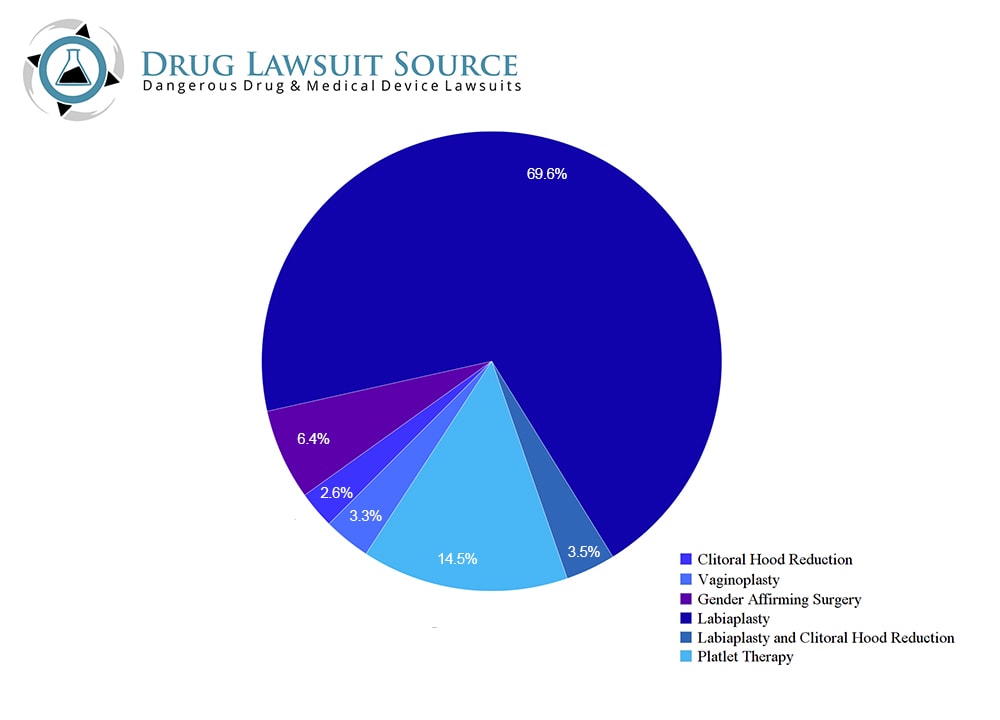Vaginal Rejuvenation Lawyer
A vaginal rejuvenation lawsuit demands compensation for injuries caused by these medical procedures. Vaginal rejuvenation is a term that covers a number of different procedures, and patients who have been harmed due to these medical procedures have the right to file a claim for damages.
Lasers and other energy-based devices are not FDA approved for vaginal rejuvenation procedures and are causing vaginal burns, long-lasting pain, scarring, and other side effects.
Vaginal rejuvenation procedures include labiaplasty, vaginoplasty, or surgeries on the labia major, or the labia minor (the smaller, inner vaginal lips).
If you had a vaginal rejuvenation procedure done and suffered harm, you may be eligible to file a lawsuit. Our vaginal rejuvenation lawyers can help you demand justice if you or a loved one has been harmed by one of these procedures.
- What Are the Vaginal Rejuvenation Surgical Procedures?
- What Are the Side Effects?
- Are These Procedures FDA Approved?
- Are There Class Action Lawsuits?
Vaginal Rejuvenation Surgical Procedures
The term vaginal rejuvenation covers several different procedures. It is also sometimes called:
- Female Genital Plastic Surgery
- Female Genital Rejuvenation Surgery
- Female Genital Cosmetic Surgery
- Vulvovaginal Plastic Surgery
- Designer Vagina Surgery
Labiaplasty
A labiaplasty is a procedure that reduces the length of the labia minora, and is the most commonly performed aesthetic genital plastic surgery. The procedure is done to reduce the labia minora so they don’t hang below the labia majora.
Clitoral Hood Reduction
A clitoral hood reduction is a procedure that reduces the length and size of the clitoral hood. The procedure decreases the amount the clitoral hood protrudes to make it less prominent.
The clitoris is covered up by a hood of tissue technically known as the prepuce. The clitoral hood serves to protect the clitoris from being constantly rubbed.
Labia Majoraplasty
A labia majoraplasty is a procedure designed to surgically reduce the size of the outer, hair-bearing labia majora. This procedure typically results in smaller, tighter labia majora. In patients with excess skin, drooping of the labia majora when the patient is standing is usually improved. In patients with excess volume, this procedure can result in a lower profile.
Monsplasty
A monsplasty is a procedure designed to reduce bulging of the mons. The purpose of a monsplasty is to reduce the amount of fatty tissue and/or skin, depending on the cause of the bulge.
This procedure results in a lower profile mons that typically projects less in clothing. In some patients with a mons that hangs, removal of excess skin can result in less hanging.
Vaginoplasty
Vaginoplasty (also known as posterior colporrhaphy) is a procedure designed to tighten the vagina. A vaginoplasty brings the separated muscles together, and the extra mucosa skin from the back side of the vagina is removed.

The above graph shows the percentages of aesthetic vaginal rejuvenation procedures performed in 2020, according to the Aesthetic Plastic Surgery National Databank. The most performed procedure is labiaplasty.
Serious Side Effects Of Vaginal Rejuvenation Surgery
Vaginal rejuvenation surgery has been found to cause several serious side effects, leading injured patients to file lawsuits with the help of their lawyers.
Vaginal Burns
Vaginal burns can cause discomfort anywhere in the vaginal area, such as:
- labia
- clitoris
- vaginal opening
These symptoms may begin suddenly or grow in intensity over time. The burning and irritation may be constant, or it may worsen during an activity like urination or sexual intercourse.
Scarring
Most vaginal rejuvenation procedures improve genital appearance but in some cases vaginal scarring has caused dead spots or a loss of sensation and thicker tissue than normal skin around the wound, resulting in additional surgery.
Significant Chronic Pain
Chronic severe pain and swelling at or around the surgical wound in the days after the anesthetic wears off.
Bleeding
Excessive bleeding from the surgical wound can lead to a blood clot forming.
Infection
Infection of the surgical area around the surgical wound where the vaginal opening area is accessible to contamination with fluid from the vaginal tract, urinary tract, and alimentary (fecal) tract.
Dryness
Vaginal rejuvenation can be used to combat vaginal dryness in women but in some cases, patients have experienced vaginal dryness after the procedure.
Adhesion
Adhesion (Labial Adhesion) is the joining of the left and right labia minora resulting in a narrowed vaginal opening (the vaginal introitus). The introitus can be as small as a pinhead when labial adhesions are severe.
An adhesion may lead to dribbling urine on standing up after passing urine.
Numbness Or Loss Of Sensation
During vaginal rejuvenation surgery, nerves can be severed or damaged, leading to either hyposensation (a lack of sensation) or hypersensation (too much sensation). Since nerves normally do not regenerate, this is a permanent side effect.
Are These Procedures FDA Approved?
In July 2018, the FDA released a statement warning that vaginal rejuvenation procedures pose serious risks. Additionally, the procedures are being investigated for deceptive advertising and unapproved uses.
The FDA has approved laser and energy-based devices for the treatment of some serious conditions, but the safety and effectiveness of these devices have not been evaluated or confirmed by the FDA for vaginal rejuvenation procedures.
Additionally, the FDA has addressed multiple laser manufacturers, warning them not to market their lasers for off-label purposes such as vaginal rejuvenation procedures. These brands include:
- Alma Lasers – FEMILIFT
- BTL Industries – Ultra Femme 360
- Cynosure – Mona Lisa Touch
- Inmode MD – FormaV, FactoraV
- Sciton – diVA
- Thermigen – ThermiVA
- Venus Concept – Venus Fiore
Are There Class Action Lawsuits?
The are class-action lawsuits filed against some of the manufacturers of the laser devices. These lawsuits allege that the manufacturers deceptively marketed the devices, and they’re unreasonably dangerous when used for purposes other than their original intention.
Contact a Vaginal Rejuvenation Attorney for Legal Aid
Our award-winning vaginal rejuvenation lawyers can help you if you were harmed by a vaginal rejuvenation device that caused scarring, vaginal burns, and significant chronic pain after your treatment.
The criteria for a claim include:
- The patient must have experienced vaginal rejuvenation surgery side effects such as vaginal burns, scarring, and significant chronic pain.
- The patient must have seen a physician for the injuries within days of the procedure and after receiving treatment.
To learn more, reach out to our attorneys today. Our legal team will review your medical records to determine if you have a case. If you do qualify for a claim, we will start your case immediately. We charge no fees unless we win.
 (866) 280-4722
(866) 280-4722 

